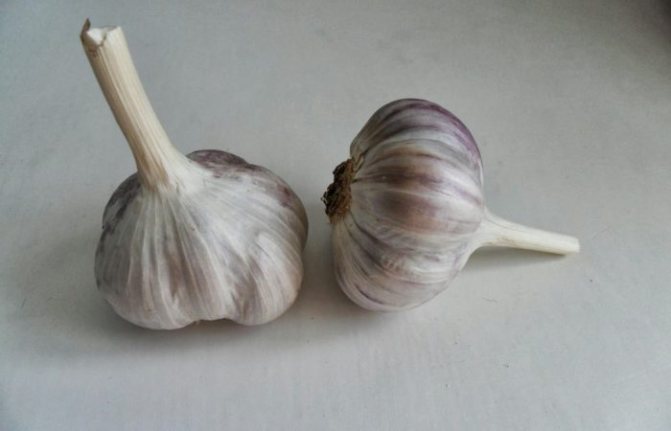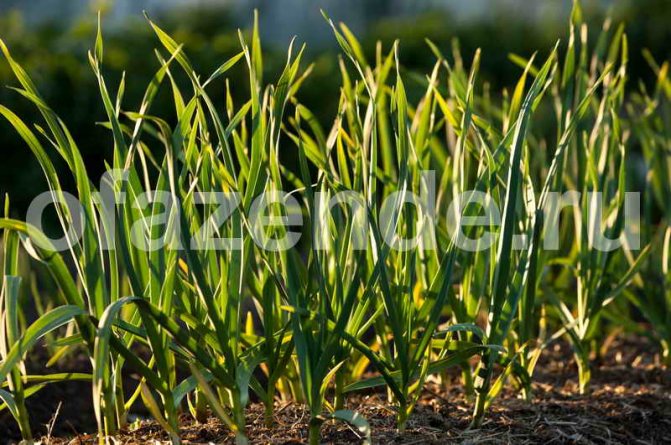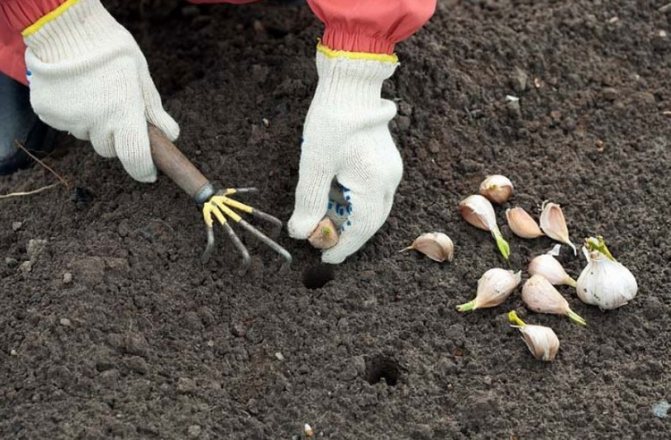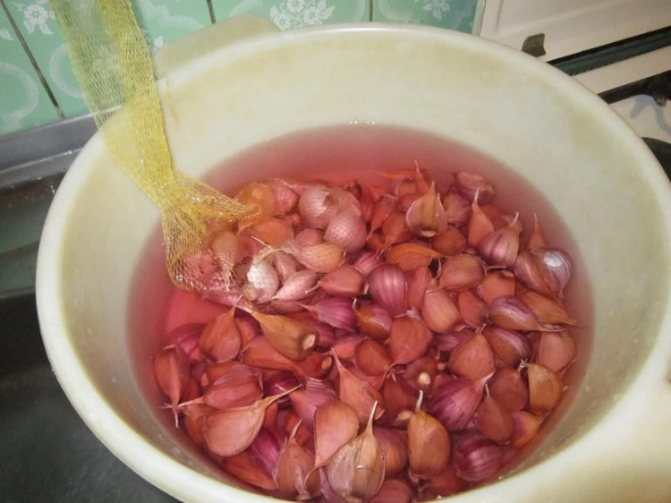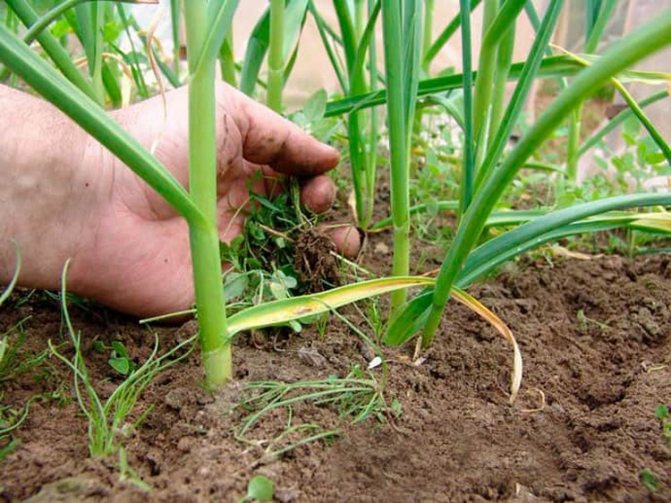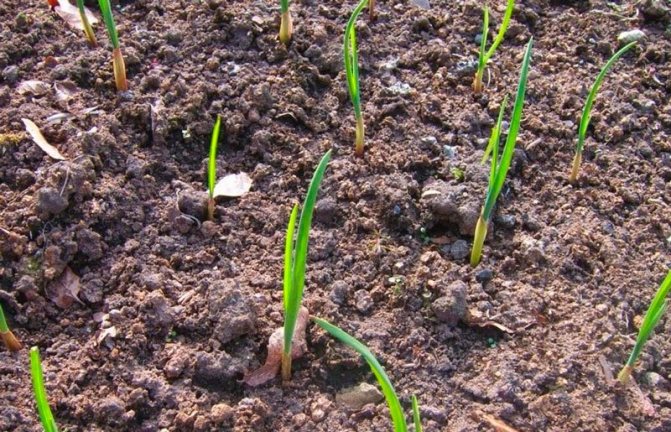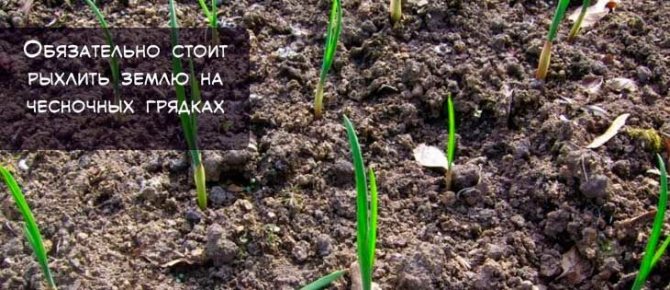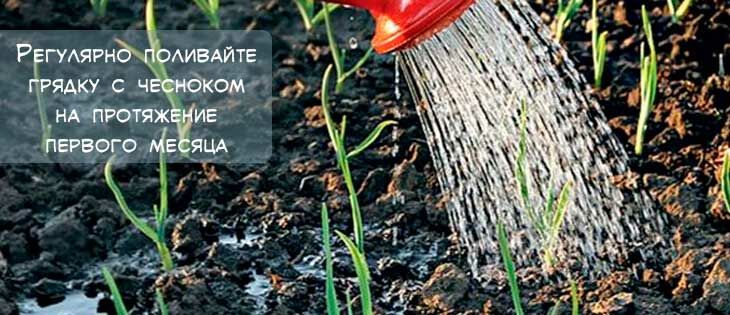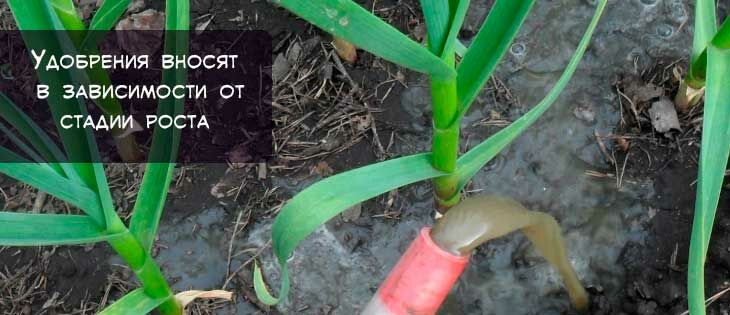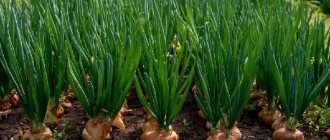We are used to thinking of garlic as a primordially Russian product. But his homeland, like many other spices, is Central Asia, most likely - Turkmenistan. As early as 4 thousand years ago, garlic was grown in the countries of Central Asia, as well as in South Asia - Pakistan and in Western Asia - Iran. If you delve into history, then of all peoples, only the ancient Romans and Greeks did not like garlic. The ancient Indians did not eat it, but appreciated its medicinal properties. For most ethnic groups, garlic was and still is an indispensable component of the national cuisine, including Russian. Can garlic be planted in spring instead of fall? Of course, yes, and many gardeners have recently been planting this bulbous plant twice a year! This ensures a stable harvest, and both spring and winter garlic have their own advantages. When to plant garlic in spring, read our article.
What season is it customary to carry out work
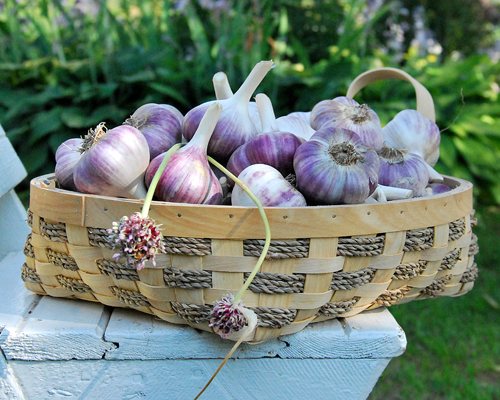
Planting winter varieties is not always successful
Growing garlic in the winter way is a tradition among Russian gardeners. In the spring, when there is so much work that you don’t know which one to grab, it’s nice to know that some plantings have already been made in the fall. In addition, the first greens that can be used for salads appear very quickly, and harvesting can also be started early. It is also believed that podzimny garlic has a brighter taste than spring garlic.
The spring planting of garlic, which is a wonder for many owners, has its advantages. Seedlings appear amicably, since the planting material gets into a sufficiently warm soil. Plants get sick less during the growing season, the harvested crop is well stored.
Transplanting a sprouted head of garlic
A transplant may be needed if:
- grown or bought seedlings;
- the garlic was poorly harvested in the fall, the heads remained in the ground, and in the spring they sprouted.
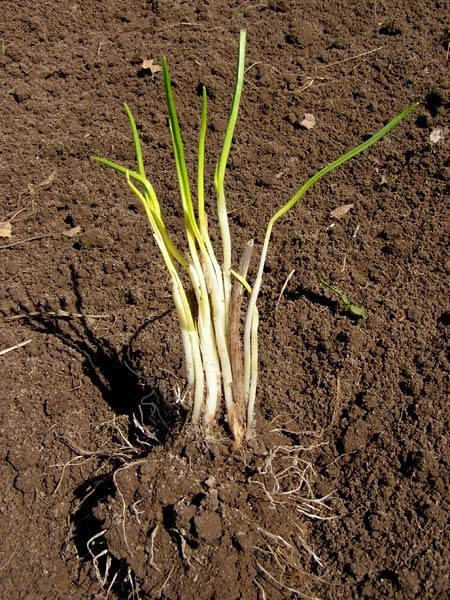

It happens that we leave whole heads in the ground, next year they can be dug up, disassembled into teeth and planted again
Garlic easily tolerates a transplant. You can take out the sprouted head, divide it into teeth and plant it on the garden bed. This must be done carefully, without damaging the roots, and quickly so that they do not dry out in the sun and wind. Make the holes deep so that the roots in them are straightened, and not bent. Water or process with a seedling rooting agent (Forte, Clean sheet, etc.).
Planting garlic in the spring has more disadvantages, but the main plus is the joy of doing what you love, they all overlap. Select the timing and scheme of planting individually, focusing on the weather and taking into account the type and variety of planting material.
What types of garlic are planted in spring
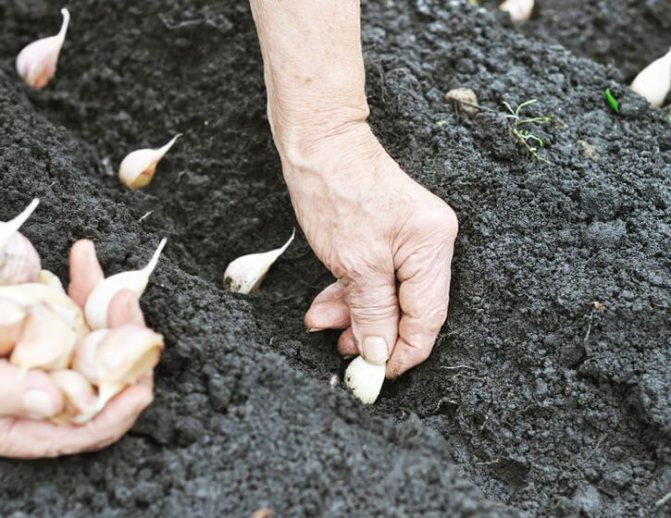

Planting with teeth is the easiest and most popular method.
The division of varieties into shooters and non-shooters is, as a rule, a division into winter and spring varieties. The former tolerate winter cold well, the latter are less frost-resistant, and it is they who are planted in spring.
Spring garlic differs from winter garlic in the appearance of the bulb: it does not have a central arrow, and the cloves are small, located in several rows. In each of the denticles, no matter how small it is, there are already rudiments of future leaves.
Breeders have bred many varieties of spring garlic, grown to obtain a full-fledged bulb - per head. For central Russia, these are:
- Gulliver - medium-late, disease-resistant, fruitful, bulbs weigh up to 40 g;
- Yelenovsky - mid-season, the weight of individual cloves can be 8 g, and a whole bulb - 50 g;
- Ershovsky - mid-season, high-yielding, in one bulb weighing 35 g there can be up to 25 pieces of cloves;
- Sochi 56 - mid-season, bulbs weigh up to 50 g;
- Victorio - differs from other varieties with a wax bloom on the leaves, fruitful, well stored;
- Flavor is the oldest of the varieties, but is still popular due to its high yield and good keeping quality of the bulbs during storage.
Any of the listed varieties can be grown in the northern regions, since they were originally intended for them, but then they were successfully acclimatized in central Russia. Specifically for Siberians, the spring mid-season variety Novosibirsk is intended, it manages to ripen in a record short time - from 75 to 85 days.
Gardeners are wondering if winter garlic cloves can be used for spring plantings. Yes, you can, but the result will upset those who would like to get large bulbs in the fall. Unfortunately, they will grow small or they will not be at all: the plant, as experts say, will go into the arrow. But winter varieties give a very good green mass, it can be used as a vitamin supplement in various dishes.
Benefits of spring planting
- The main advantages of spring planting:
- obtaining a crop of long shelf life;
- friendly shoots;
- minimizing the risks of losing crops due to recurrent frosts.
Did you know? Garlic releases volatile substances called phytoncides, which are a natural antibiotic. With their help, the plant protects itself from pathogens. These properties are used in medicine. During epidemics, the Old Slavic peoples made special hand-made amulets from garlic, which were worn around the neck. Phytoncides, penetrating the lungs along with the air, act on the body like modern inhalation agents.
What landing methods are there
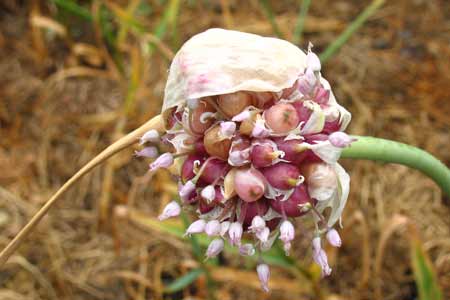

This is what a bulb of garlic looks like
The most common planting method is with teeth. The result of such plantings is large heads of garlic. But not all owners of orchards know how to use bulbs for planting, but it is imperative to master this method: it makes it possible to get your own high-quality, and most importantly, healthy planting material.
The owners usually get rid of most of the arrows in late May - early June. This is done so that the arrows do not take away from the plant the forces necessary to form the bulb. It is still advisable to leave a couple of arrows (the strongest) - it is on them that the bulbs with tiny teeth-seeds ripen.
At the end of June, the film with which they were covered begins to crack, which means that the future planting material is ripe. The arrows must be cut, tied and hung to dry in a well-ventilated dark room (in the sun it is impossible, under the influence of bright rays the seeds "turn glass" and lose their germination). When they are dry, the bulbs can be separated from the inflorescences, and then used for planting - pre-winter or spring.
Interesting fact: from each arrow you can get from 20 to 100 onions. If you use an ordinary large onion for planting, then there will be from 4 to 10 cloves in it, which means that for the future harvest you will have to spend the lion's share of what has just been harvested. The benefits of using bulbs are obvious, especially when it comes to varietal garlic, which you would like to see more on your site (the varietal qualities of seeds from bulbs, by the way, are completely preserved).
Experts explain: every year garlic bulbs become smaller and smaller if propagated by cloves from the same plant. Garlic needs rejuvenation every 3-5 years. This problem can be solved with the help of bulbs.
Cultivation technology and features of sowing seeds in the country
Each sowing period is distinguished by certain features that relate to the work. However, experienced gardeners recommend adhering to the general rules of agricultural technology, regardless of what time the garlic is planted:
- Before starting sowing, the planting material must be calibrated. It is necessary to sow heads without defects and traces of diseases.
- A common mistake that gardeners make is sowing a winter variety in the spring. It is possible that there will be a harvest, but the garlic will not please with its excellent taste characteristics and large size.
- To be content with a rich harvest, it is worth giving preference to zoned varieties. It is also necessary to familiarize yourself with all their characteristics and sowing technology.
- Once every three years, it is necessary to rejuvenate the variety.
Instead of prongs, the bulbs will become the planting material. Of these, in the first season, one-toothed teeth ripen. The harvested crop is intended for planting next season. Such events will allow to renew the plant culture.
- To obtain a high-quality harvest, it is unacceptable to miss the established deadlines. In this case, you need to focus on the arrow that should burst. It is also necessary to monitor the appearance of bulbs.
- High yields can also be influenced by plucking garlic feathers regularly. The main rule, from which one should not deviate when sowing garlic, implies strict adherence to the timing.
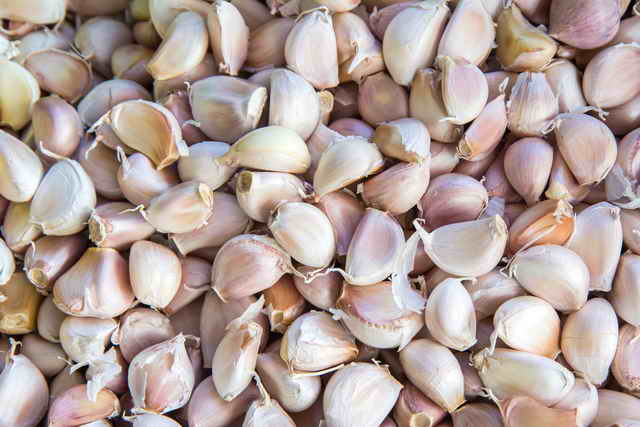

Before planting, the seeds need to be calibrated. Illustration for this article is used under a standard license.
If sowing is planned in the fall, planting seeds early is unacceptable. Otherwise, they will hatch ahead of time. As for the spring period, do not hesitate with planting, since the heads may not have enough time to ripen.
Dates of planting garlic in spring, depending on the region
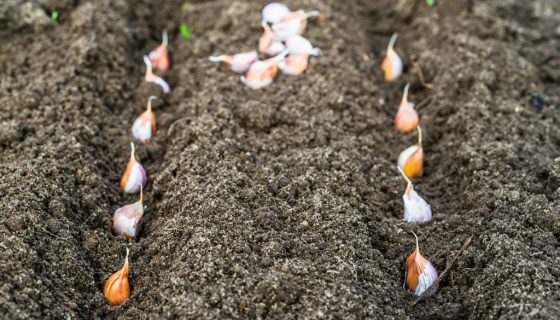

In the Urals, winter sowing is more respected, but they do not disdain spring sowing either.
Garlic is a frost-resistant culture. The timing of its planting in any of the Russian regions is determined according to general rules: as soon as the snow melts and the earth warms up to +6 degrees, work can begin. In the Kuban it will be the end of the first decade of March, in the Moscow region - the end of April, in Siberia and the Urals - the first decade of May.
First, the plant forms roots, and at a soil temperature of 8-10 degrees, the aerial part of the garlic will grow. It is impossible to delay planting: melt water may dry up (and garlic loves moisture) and the plant will wither, there is also a danger that the bulb simply will not have time to ripen in the short period of time that will be allotted to it.
According to the observations of experts, if you plant spring garlic when the air temperature steadily goes beyond +5 degrees, then you can not wait for the bulbs in the fall - the garlic will increase the green mass and nothing more.
How to transplant garlic planted before winter in the spring
Often, summer residents are faced with a situation when, after the autumn planting of garlic, it becomes necessary to transfer it to another place. Experienced gardeners do not recommend carrying out such activities, since during transplantation there is a risk of damage to the root system. If a decision is made to define the culture elsewhere, the planting should be transferred along with a large earthy clod. In this case, the losses will be insignificant, but the harvest will not please with generosity.
If you want to grow garlic in your summer cottage, you should not be afraid of this process.All the work related to the preparation of seeds and sowing is not at all difficult, the main thing in this matter is to clearly follow the instructions and take into account the recommendations of experienced gardeners.
Soil preparation and outdoor planting instructions
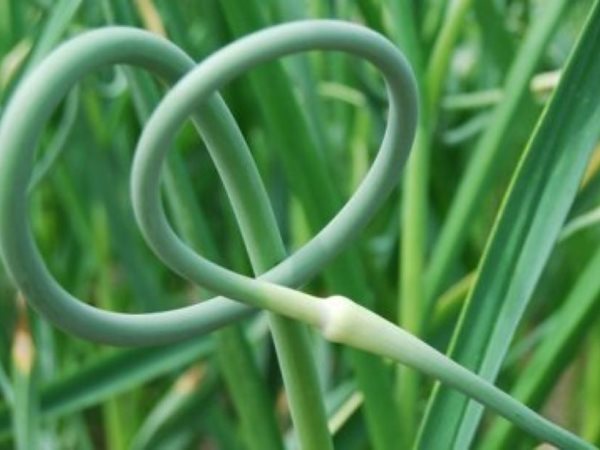

Arrows of garlic are also called wild garlic
It is not recommended to plant garlic on the same bed for several years - the yield will certainly decrease. It is desirable that zucchini, peas, cabbage were the predecessors of garlic.
Spring garlic is planted on the heads in well-prepared soil. It should be loose so that the water circulates through it freely, nutritious - for this, humus or compost is introduced into it a couple of weeks before planting. When 2 days remain before planting, the soil in the garden will need to be watered with a solution of sodium chloride (1 glass per 10 liters of water). This procedure has two functions: salt will protect future plants from the pest - onion flies, and also accelerate the dissolution of nutrients so that it is easier for the roots to absorb them.
The planting material is prepared as follows: the heads of garlic are divided into cloves, the damaged ones are discarded. Wrapped in a damp cloth and kept in a cold place for several days, or in the refrigerator. 0.5 days before planting, the cloves are dipped into a container with warm water. It will be useful to treat planting materials with growth stimulants, which can be bought in specialized stores for gardeners.
And here's how to plant garlic.
- Prepare rows, the distance between them is 20 cm. Mark holes in each row (after 6 cm). If the variety is large-fruited, the distance between the holes should be increased to 10 cm.
- In each hole, lower the clove with the bottom down, the depth is no more than 2-3 cm. You cannot press in the clove, you can injure the roots.
- Sprinkle the plantings with earth.
- Sprinkle with plenty of water.
- Apply fertilizer (e.g. ammonium sulfate).
Garlic shoots should be expected after 14 days.
When planting garlic on the arrow (to obtain seed), the cloves are especially meticulously selected - they should be the largest. The landing site must be sunny. Planting is carried out as usual, but the distance between the holes is increased - future plants should feel free in the garden.
And here is how experienced gardeners grow garlic from seeds. The area allocated for planting is mulched with two or three layers of newspapers, which must be watered. The site is conventionally divided into rows, holes are made in them, a tiny tooth is lowered into each. Then the newspapers are covered with earth (the layer must be thin so that the plants have enough strength to overcome it). Thanks to this technique, it is possible to get rid of weeds that could destroy the plantings.
How to plant spring garlic: video
Preparation of planting material
Divide the heads of garlic into cloves, being careful not to damage the sharp top - the growth point. If the "shirt" was removed - it's okay, you can plant without it, but you don't need to specially clean each clove. If they are dry, soak them in clean water for a day. Then the cloves must be germinated in one of the following ways:
- wrap in a damp cloth and keep in room conditions. There are recommendations to put it in the refrigerator for a week on the bottom shelf;
- put in a plastic bag and spray with water, can be treated with a growth stimulant (Zircon, Epin, HB-101, etc.). Do not tie the pouch, the teeth should breathe. Keep at room temperature until seedlings emerge.
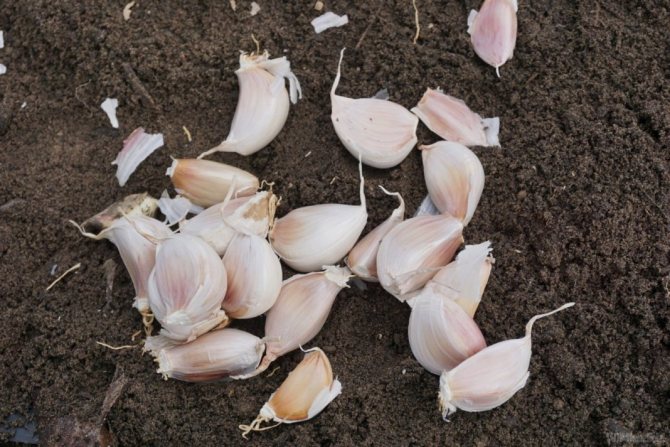

Before planting, the cloves of garlic must be soaked in water or treated with a growth stimulant
Before planting, rinse the garlic in a pink solution of potassium permanganate, and then dip it in salt water for 1 minute (1 tablespoon per 1 liter of water). The air bulbs have not yet been in the ground, therefore they are clean from diseases and pests; before sowing, they must be treated only with a growth stimulant.
Video: how to properly divide the head into teeth
How to care for a planted vegetable
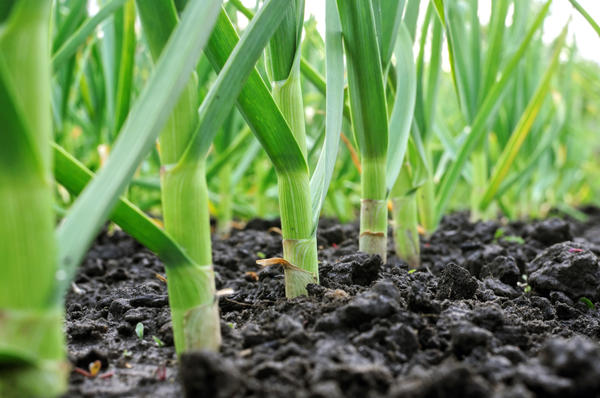

Garlic will quickly turn yellow from lack of watering.
Garlic planting maintenance is simple, but it should be regular:
- watering is necessary (water temperature is from 15 to 20 degrees), however, their excess can injure the roots, watering is completed 2 weeks before harvesting;
- potash and phosphorus fertilizers are used as top dressing;
- the earth is loosened (after watering - it is necessary) so that air circulation is not disturbed;
- get rid of weeds, if this is not done, full-fledged bulbs will not form;
- the extra arrows are removed, leaving only those from which the seeds will be obtained;
- planting, if such a need arises, protects against pests and diseases (one of the most common is fusarium).
How to plant garlic with chives on the head in the beds
- Planting depth.
It is recommended to plant it to such a depth that the soil layer above the top of the clove is about 2 cm. This is on average 5-6 cm. The teeth are laid out on the soft soil grooves or holes vertically, bottom down, without pressing.
- Landing distance.
The distance between plants in a row should be at least 8-12 cm.
- Landing scheme.
For the convenience of caring for the garlic, the ridges need to be cooked not wide, 4-5 rows should be placed on them with a distance of 20-25 cm.The passages between the ridges are left from 50 to 70 cm.Depending on the processing method, garlic can be planted according to different schemes, but avoid thickening.
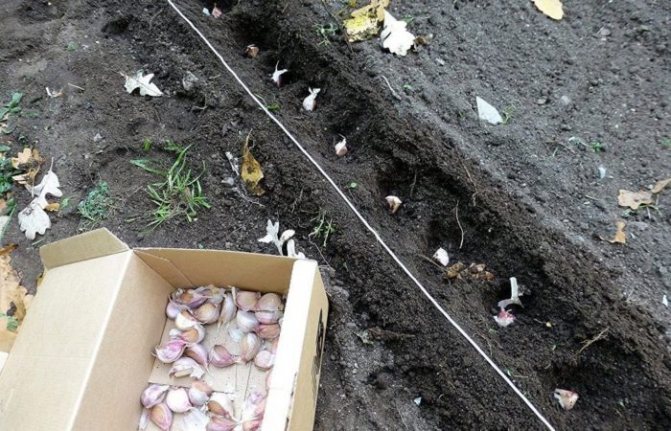

Caring for garlic after planting
If a planting summer garlic in spring carried out according to all the rules, the first green shoots appear in a week. Cold nights and morning frosts are not terrible for the plant. Garlic beds turn green already at 4-5 degrees Celsius.
It is not difficult to take care of the garlic area if, after planting, fill the soil with mulch for 2-3 centimeters (humus, peat, compost). You will have to loosen the aisles with or without mulch. But mulching allows you to run with a hoe in the garden much less often.
Watering
It is necessary to water the hot garlic with the appearance of the first greens. For large heads to form, the plant requires a lot of moisture. The first signs of insufficient watering appear on the yellowed tips of the leaves.
In regions with rainy weather since spring, garlic plantations do not require additional watering. It's just that after each rain the aisles are necessarily loosened. Growing heads need oxygen access.
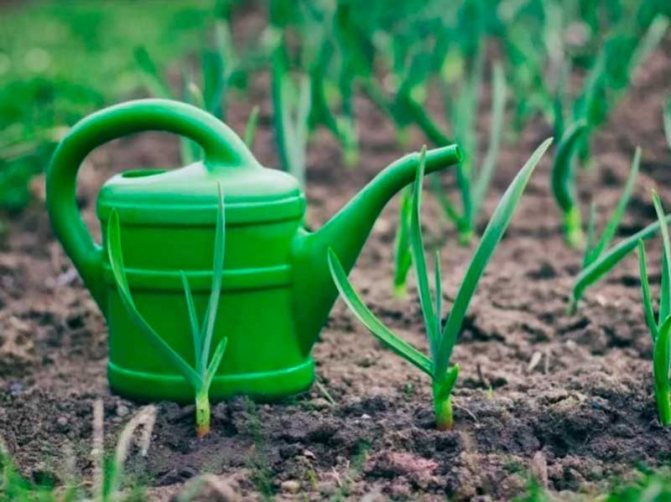

Top dressing
On poor soil, not fertilized for years, garlic does not grow. Therefore, a plot for cultivation is prepared in the fall, fertilizing with organic matter. After the appearance of the first green shoots, the soil is enriched with nitrogen-containing fertilizers:
- mullein solution (1:10) or bird droppings (1:12);
- use an infusion of herbs;
- sprinkle the aisles with humus;
- use mineral fertilizers (according to the instructions).
Repeated watering at the root is carried out on the 10-14th day. When the cloves are formed (June-July), the garlic beds are watered with wood ash diluted in water, replenishing the plant with potassium and phosphorus.
Environmentally friendly products are grown only with the help of organic matter. It is better not to use chemical preparations so as not to damage your health.
Protection
Although garlic has many protective properties, the crop is attacked by harmful insects and microorganisms. With the appearance of the first greenery, hordes of dangerous enemies gather on garlic beds, including root mites that infect the heads of garlic from the inside.
If the beds are located in lowlands, garlic is affected by black mold, fusarium, white rot. It is necessary to start the fight against all enemies on time in order to prevent the loss of the harvest.
Preventive treatment of the beds is carried out in the spring, spraying with ammonium sulfate. Repeat the treatment at the beginning of the summer period. It is necessary to periodically inspect the plantings in order to find pests in time.
The affected plant, after identifying the problem, is immediately removed from the garden. Thickened plantings of garlic must be thinned out.
Spring and winter: what is the difference
Garlic is a perennial bulbous plant. It is divided into two types: winter, which is planted in autumn, and spring, ready for planting in spring. The main differences between the two types of this culture are as follows:
- They differ in terms of planting. You can plant winter garlic before winter, and in the spring it will sprout and begin to grow. Spring garlic can be planted only in spring, it does not tolerate wintering in the open field.
- Winter varieties produce an arrow with airy bulbs, they are called bulbs. They serve for reproduction. Spring varieties, except for the Gulliver variety, do not produce such shooters.
- One bulb of spring garlic contains about 30 cloves, and winter garlic has less than a dozen of them.
- The cloves in spring garlic are arranged in a spiral, smaller ones closer to the center; in winter garlic, all cloves are located around the peduncle in one row.
- The winter variety has larger heads, like the cloves themselves, its yield is higher.
- Spring garlic is propagated by cloves, and winter garlic can be obtained by planting single cloves, bulbs or cloves.
- Spring varieties are easily stored all year round.
The main differences between spring garlic and winter garlic
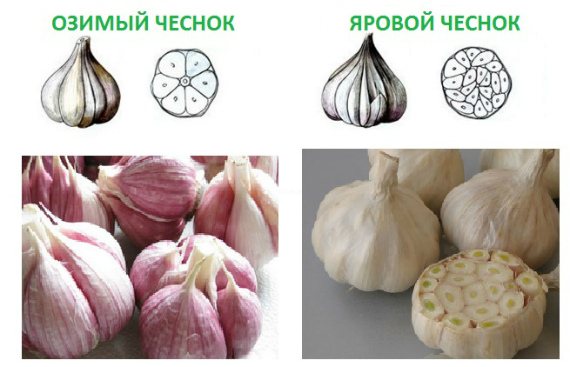

The main difference between spring garlic and winter garlic is that it does not shoot, so the vegetable can only be propagated with cloves. They are located randomly inside the head, while the winter garlic cloves grow in a circle around the arrow.
Spring garlic has thinner covering scales, pure white in color (in a winter vegetable, the husk can be gray-yellow or light purple). It is somewhat smaller than its winter counterpart, the teeth are small, there are many of them in the head.
The taste of spring garlic is less spicy, but has a pleasant sweetness. It is perfectly stored and used in salads, for fresh consumption.


